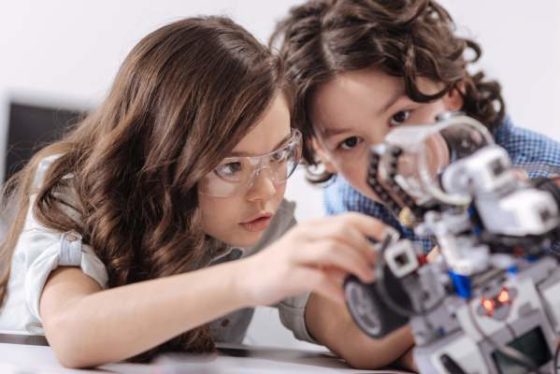Fun And Easy Ways To Encourage STEM Education For Kids
There are so many reasons to introduce your child to the great big world of science, technology, engineering and math (STEM).
These disciplines arm youngsters with fundamentals they will undoubtedly carry with them throughout their lives. They include problem-solving, spatial reasoning (the ability to see a two or three-dimensional object and then mentally manipulate it.), creativity and critical thinking.
What’s more, mastering these fundamentals sets your kids up for success in the most in-demand, high-paying fields now and in the future. Here are some of the best ways to plant STEM seeds early at home, school and in the community.
1. Approach it Hands-On: Creating Interactive Activities
One of the most foundational aspects of early childhood STEM is exploratory play. This is also known as the play of curiosity and inquiry.
Your child discovers new things through interactive play, such as taking something apart and putting it back together. Subtly your child is learning important STEM-based concepts coupled with fine motor skills, hand-eye coordination, and critical thinking.
Here are a few of our favorite hands-on STEM activities you can do at home.
-
Ages 2 – 4: Magic Milk Rainbows
This toddler-friendly STEM activity has it all: science, rainbows and plenty of opportunities to make a mess! The demonstration, which uses milk, food coloring, and dish soap to create liquid rainbows, teaches youngsters about surface tension and color mixing. Get the instructions here.
-
Ages 5 – 10: Homemade Lava Lamps
Bigger kids will find this craft/experiment totally groovy. You can use empty water bottles, food coloring, baby oil, Alka-Seltzer and other things you have lying around the house.
This will teach kids a mesmerizing lesson about oil and water density with a DIY lava lamp. Get the instructions here.
-
Ages 10+: DIY Rockets
Blast off! If you experimented with rocket-building in school, you probably remember it well. You can give your kids the same excitement by creating educational rockets at home to illustrate basic chemistry, engineering and physics concepts.
The coolest part is, it requires no fire or fuel – mixing the baking soda with vinegar causes an explosive reaction that blasts off the ship. Get the instructions here.
2. Make it Fun: Invest in STEM Toys and Tools
Take a stroll through the local toy store and you’ll see tons of awesome toys designed for learning and experimentation. From boxed experiment kits to next-level LEGO sets, it’s easier than ever to fill your home with awesome learning tools disguised as toys, all of which will fascinate your budding scientist for hours on end.
Here are some good STEM toys any youngster will love.
-
A Kid’s Microscope with Specimen Slides
Whether your child is a mad scientist in training or a budding biologist, a microscope kit will be at the center of their world, now and as a grown-up. These awesome kid-friendly microscope kits come with everything you need to teach microscopy to your youngster.
They also include the scope itself, slides, tweezers, Petri dishes, tweezers, and many other microscope mainstays.
-
A Kid’s Telescope for Star Searching
Space is sort of like the gateway science. As complicated as it is, for whatever reason, kids find it super cool (and it is, of course) and many sustain their interest in astronomy through childhood and into adulthood.
You can introduce astronauts-in-training to the world of space with a kid-friendly telescope for viewing the cosmos from the front porch.
-
A Toy That Teaches Kids to Code
Have you noticed the many incredible coding toys that have popped onto the market lately? These brilliant little accouterments also come in options for kids of all ages, with everything from programmable robots for preschoolers to addicting coding games for big kids and teens.

3. Get Social: Joining the Local Science Community
Forging a deep, personal interest in STEM concepts is important for helping all kids thrive. However, adding a social or community-minded component can help deepen the interest and help your little one make lifelong friends in the process.
Through your local science center, club, camp or competition, your budding STEM pro will be able to connect with like-minded learners.
-
Head to the Local Science Center
Ideally, your community has several science-focused public entities, whether that be an expansive local parks system (and, if you’re lucky, a kid-friendly nature center), a children’s museum, a natural history museum or a science center.
These institutions not only provide you with lots of scientific fun and activities, but they also offer the chance for bigger kids and teens to forge friendships with others who love STEM, too.
-
Join a STEM Club or Head to Camp
According to the National Science Teachers Association, STEM clubs have been on the rise since 2010. Whether based in schools, neighborhoods or communities, STEM clubs introduce kids to organized fun in social settings.
There are also various STEM camps throughout the country that give curious kids a totally immersive STEM-based experience for several weeks in the summer. From Space Camp to Math Camp, there’s an education-based camp that will pique the curiosity of any kid.
-
Join the Competition
Who says scientists, engineers, and mathematicians aren’t competitive? Head on over to a local robotics tournament and you’ll see a whole different story!
The best part about this kind of activity is that it teaches kids, especially teens and pre-teens—the value of teamwork and leadership, which often gets lost in the individuality of many STEM activities.

Encouraging Inclusion
All of the above activities serve as small but effective ways to inch these fields of study more towards inclusion and openness. If all kids, regardless of race, gender or socioeconomic status—are introduced to these disciplines early and taught that they are not off-limits to them based solely on their background the world will be a much better place.
STEM is the future, so let’s foster it in the present! If you’re seeking ways to motivate your child to learn, whether it ’s school work or some language, here are some strategies you should think of applying.






